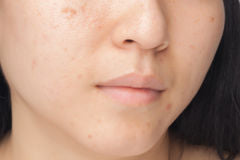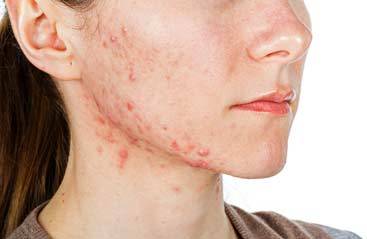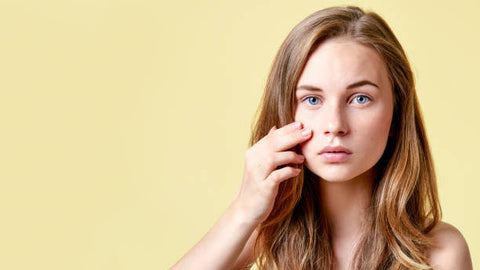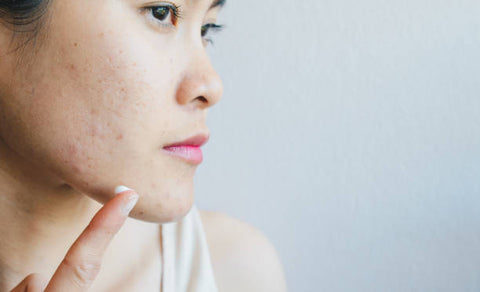Spotting the Type of Acne You Have and How to Treat It

The definition of acne goes far beyond just pimples. There are different forms of acne, each with their own distinct characteristics.
When your pores get clogged, the formation of acne soon follows. Such breakouts can be caused by a variety of culprits, from ingrown hair to dead skin cells and even foreign particles from your surroundings. What many people aren’t aware of is that different forms of acne are actually caused by different sources.
Knowing what type of acne you’re experiencing is essential to finding a solution. It can also help you figure out what might be causing your breakouts so you know what to avoid in the future. If you’re experiencing frequent breakouts, then it’s best to stay informed on how to deal with them.
Let’s take a closer look at the different types of acne and how to treat each of them.
What Causes Acne?
Acne is caused by the build-up of a type of natural body oil called sebum inside your hair follicles. Oil glands inside your skin produce sebum, which is then secreted through the follicles and onto the surface of your skin.
When a follicle is blocked, sebum starts to collect inside along with skin cells and hair, marking the beginning of acne formation. When bacteria infect the clogged follicle, swelling ensues and an acne lesion soon forms.
However, there are many different factors that may cause such clogs. Hormone levels are the most well-known cause of acne as made evident during puberty. The hormone androgen causes oil glands to produce more sebum than usual, which can cause cellular walls in pores to break down.
Menstruation is also one possible cause of acne breakouts as hormone levels are typically higher than normal during this period.
External factors like pollution or greasy cosmetic materials may also cause acne. Furthermore, medicine that contains androgen or lithium may further contribute to hormonal imbalance, thus triggering an acne breakout.
Different Kinds of Acne
Acne can be divided into three categories, each with their corresponding causes, types of infection, and treatments.
Non-inflammatory Acne
As the name explains, this type of acne involves no inflammation of a clogged pore. Non-inflammatory acne does not cause swelling and is typically painless.
Comedones are the primary types of non-inflammatory acne. These are more commonly referred to as blackheads and whiteheads. A single comedo refers to a hair follicle clogged by oil, skin cells, or other forms of debris that causes small bumps to appear on your skin. Whether the pore opening over a comedo is open or closed determines what type of acne it is.
Whiteheads are called closed comedones in medical terms. These bumps are small and white or yellowish in color and they’re usually surrounded by reddish and wrinkled skin.
Blackheads, or open comedones, are also caused by clogged follicles. However, since the affected pore remains open, the bump is exposed to oxygen. The material causing the clog begins to oxidize, giving blackheads their distinct black color.
It’s important to note that either type of comedo can cause an outbreak of pimples if they’re left untreated. Luckily, getting rid of them isn’t as difficult as other forms of acne.
There are plenty of over-the-counter solutions to comedones. Gels, moisturizers, and creams containing Ingredients like salicylic acid and benzoyl peroxide can help break down whiteheads and blackheads effectively.
Alternatively, a few home remedies and lifestyle changes can be just as effective. Proper hygiene, a balanced diet, and managing your stress levels can all serve to eliminate and prevent the formation of these comedones.
Mild Inflammatory Acne
This type of acne is more aggressive than the non-inflammatory ones. These are usually more irritating than blackheads or whiteheads due to the swelling caused by bacteria or other agents. Pustules and papules are the most common types of mild inflammatory acne.
Pustules are small pimples on the skin that contain pus. They’re characterized by their white or yellowish color and red ring that surrounds the bump. Like any other form of acne, these are caused by clogged pores, but the inclusion of certain bacteria causes them to swell unlike normal whiteheads.
Papules are very similar to pustules in appearance, but they do not contain any pus or liquid inside them. These are red or pinkish bumps that often form clusters that resemble rashes.
Pustules and papules typically disappear over time. In case you feel like they’ve overstayed their welcome, you can try using acne medication or home remedies.
When cleaning acne-affected areas, try to use your fingers when scrubbing and avoid using washcloths. Rough materials may cause further irritation or cause pustules to burst if not handled carefully. Use soap and warm water when cleaning and try to avoid applying cosmetics on the affected area to prevent any more breakouts.
Severe Inflammatory Acne
Severe acne occurs when bacterial infection reaches deep beneath your skin. The resulting infections can result in the formation of either nodular or cystic acne.
Nodular acne, or simply nodules, is very similar to the other less serious forms of acne. However, instead of having acne “heads” on top of your skin, nodules lie deeper within. They may appear as simple red blemishes or skin-colored bumps and they are significantly more painful to the touch. These may also infect more than one pore at a time.
Cysts are just as severe as nodules. Pus-filled growths caused by any combination of oil, hair, and dead skin cells form deep within your pores, creating large and painful bumps. These cysts are often tender and reddish in color. They commonly occur in people with oily skin, but teenagers, women, and older adults may also experience this type of acne with some degree of frequency.
Unlike the milder forms of acne, nodules and cysts require more care and attention if you want to recover from them. Most over-the-counter products may offer some relief, but they usually aren’t enough to eliminate severe acne completely.
If you’re experiencing either type of acne, it would be best to consult a healthcare professional in order to receive a prescription. You can expect to get some antibiotics to help fight the bacterial build-up under your skin as well as some prescription-strength versions of benzoyl peroxide and salicylic acid.
Best Practices to Prevent Acne Breakouts
If you’re worried about experiencing serious acne breakouts, try incorporating some anti-acne practices into your daily routine.
Proper hygiene can play a significant role in the prevention of acne formation. Washing your face at least two times a day can prevent pimples, whiteheads, and blackheads from forming, while bathing regularly can keep other parts of your body acne-free. Use lukewarm water and avoid rubbing on your skin too hard.
Cutting down your intake of oily or high-carb food is also a good step towards acne prevention. Managing your stress levels can keep your hormones in check, preventing breakouts from happening.
Lastly, never hesitate to visit a doctor if you think your acne problem is getting out of hand. If blemishes are still forming regardless of the steps you take to prevent them, then a professional may be able to provide you with a longer-lasting solution.


